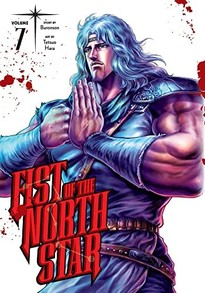Review
by Grant Jones,Fist of the North Star
GN 7
| Synopsis: |  |
||
Rei and Yuda's conflict comes to its dramatic conclusion, and the cost is higher than any could imagine. But it isn't long before Kenshiro encounters even more powerful Nanto users: the noble Shu and the sinister Souther. Souther and his minions keep abducting children, forcing Shu and Kenshiro to challenge him in the shadow of his massive pyramid. But shockingly, Hokuto Shin Ken is no match for Souther, making even the mighty Kenshiro struggle as the battle rages on. Fist of the North Star is written by Buronson, with art by Tetsuo Hara. Fist of the North Star Volume 7 is translated by Joe Yamazaki, with lettering by John Hunt and editing by Mike Montesa. |
|||
| Review: | |||
This is the best of what Fist of the North Star has to offer. There are many legendary moments throughout the series, and certainly, there are higher highs and more iconic moments than what happens here in Volume 7. But I think this stretch of chapters helps make up what I consider the “resting state” of the series. All the players involved, the drama between them, and the general mood are where everything clicks perfectly. Volume 7 illustrates when the series is even more than the sum of its parts - and those parts were already excellent. By this stage in the run, Buronson and Tetsuo Hara had tapped into the one-two combo that makes the drama sing: the brothers and the Nanto secondary. The introduction of the Hokuto Shin Ken brothers Raoh, Toki, and Jagi serves as the first central pillar of what makes this series so iconic. The drama between these four is everything to the series, and this ongoing tension propels the martial arts spectacle to the heights of melodrama. We're all here for the battle over who the true successor to the legendary fist should be. This period in Volume 7 shines because the first significant confrontation between Raoh and Kenshiro is out of the way. When Raoh enters the picture, there's this gravitational pull between him and Kenshiro, a feeling from the audience that they must fight immediately so Kenshiro can end his reign of terror. But now that they've had their battle and both are recuperating, unable to really get the upper hand on one another, we're in this great space narratively where not only do we have the ongoing tension between them, but they can't act on it at the moment. This is perfect for the dramatic stakes on all fronts. Raoh can sell the fear of Souther by saying that even he doesn't know how to defeat him. Raoh can also lend Kenshiro a hand while having selfish ulterior motives - and baby, that's the stuff shonen fighting manga is made for. The status of friend or foe, brother or nemesis, constantly shifts in the blasted wastelands of 199X. It's hard not to get swept up in the twists of fate and irony as Raoh carries a wounded Kenshiro to safety but leaves before anyone can even notice his work. But the other element that sells all this is the Nanto secondary heroes, Rei and Shu. All the agony of Rei's final moments and his battle with Yuda are fraught with tragedy. There are copious amounts of blood and more than a few genuinely epic soliloquies, but even victory feels hollow as he goes to his end. Rei's curtain call in the cabin has to be one of the greatest moments in the entire series and one of the grimmest images in the whole run. You get the sense that Buronson and Tetsuo Hara were aware that they were onto a good thing with Rei, so Shu very quickly enters the picture. Don't get me wrong, Shu is amazing, and he's my favorite Nanto user, a distinct and engaging character in his own right. But it's not hard to see that Kenshiro and Rei are a fantastic duo, and as soon as Rei exits the picture, another long-haired Nanto user enters the manga and buddies up with Kenshiro pretty darn quickly. They realized that this was a winning… formula seems harsh, as Rei and Shu are very very different characters in execution, but a winning dynamic at the very least. So you've got the ongoing tension with the Hokuto brothers, a partner warrior in a friendly Nanto user, and villains defying them in martial arts and terrible fate. To my mind, this is the quintessential Fist of the North Star experience. When I think of the series, this is where my mind's eye goes. Plenty of established characters are running around getting into dramatic fistfights, and there are lots of moving parts, but we have yet to move to end-game scenarios or grand resolutions. Combine that with iconic imagery like Rei in the cabin or Shu on top of the pyramid, and it's a home run every chapter. I would never say that these releases are particularly long reads, but as soon as I cracked the cover on Volume 7, the next thing I knew, I was at the end. If you've kept up with the series this far, then prepare for some of the absolute best it has to offer. |
| Grade: | |||
|
Overall : A+
Story : A
Art : A+
+ Some of the best material in one of the greatest manga of all time |
|||
| discuss this in the forum (6 posts) | | |||
| Production Info: | ||
|
Full encyclopedia details about |
||